What’s Growing On?
Flowers always make people better, happier, and more helpful; they are sunshine, food and medicine for the soul. ~ Luther Burbank
Around this time of year I start to get spring fever, that urge to go outside and dig around and plant something. Even if you naturally don’t have a green thumb, flower gardening allows you to use your artistic playful side, being outside in nature soothes your soul, and a beautiful flower garden increases the curb appeal of your home. One of the first things a flower gardener learns is that there is not one date when it is best to plant all flowers.
This group of exotic and tropical summer bloomers can be planted right now and all through April in most of the country; planting times for colder regions of the North are typically from April to June, depending on the bulb.

Cannas are a personal favorite for their showy, tropical-like flowers and vibrantly-colored or variegated banana-like leaves. Dahlias offer numerous flower types from dazzling daisies, to showy pom poms, to show-stopping colorful blooms. Other note-worthy spring-planted bulbs include gladiolus, windflower (Anemone coronaria), pineapple lily (Eucomis), freesia, summer hyacinth (Galtonia), begonia, red hot poker (Kniphofia), Asiatic and Oriental lilies (Lilium), and Aztec lily (Sprekelia). 
So start by finding an empty spot in your yard that you see frequently that could use some color. If you don’t have an open bed, remove a patch of lawn in front of shrubs. Measure the size and note what time of day and how long the sun shines on that spot. Consider the following when designing your garden: hardiness, color, fragrance, height, time of bloom and size of plant. Do you want to attract hummingbirds, butterflies, or song birds? Or are you trying to create a work of beauty just for you? Next, visit your favorite full service nursery. They will help you pick out the right flowers for that spot. And be sure to ask about fertilizer, weed preventer and mulch.
Here are three easy ways to start planting your summer bulbs:
- Start with bulbs that are plump, firm and feel heavy for their size. Prep the soil by working a complete fertilizer into the entire bed or bottom of planting holes.
- Arrange the bulbs in groups or random clusters, then plant them at the depth recommended on the package with the pointed side or sprouting side facing up.
- Cover the bulbs with soil mixed with compost and keep the soil moist to slightly moist from planting until the foliage of the mature plant dies back.
One of the biggest things about gardening is the upkeep, depending on the plants and flowers you choose this can require little maintenance or high maintenance. Be realistic about your daily scheduled and how much effort you are willing to put in weekly to maintain your gardens.
Work all day? Busy with kids? Then opt for low maintenance plants that need very little maintenance or call DK Landscaping to keep your yard looking beautiful all year long! (707) 280-3632.
Springing Forward
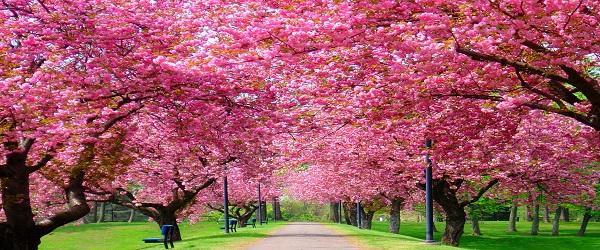
Spring is an exciting and one of the most beautiful times of the year. The days are becoming longer, the weather is getting warmer, you awake to birds chirping in the morning, and spring blooms and lush green plants come alive in your landscape.
After a long winter, your lawn and gardens may be looking a big ragged and dreary. So before you pull out your lawn furniture from storage, get in the “spring spirit” by getting your yard looking spectacular. Help your lawn, trees and shrubs get off to a healthy growing season with these six luscious landscaping tips:
1. ASSESS YOUR TOOLS: Check, maintain, sharpen and repair your landscaping tools for a smooth spring and summer experience. This includes your lawnmower, weeding/pruning tools, rake and edger.
2. CLEAN UP: Clean out dead leaves, branches, trash or anything else that could impair your garden and lawn’s growth. Prune
3. WEED CONTROL: Uproot any existing weeds you find out of flower beds and check your lawn for any weed growth, whether they’re leftover stalks from last year or brand-new shoots. Once weeds are clear, DK Landscaping recommends spending between 10-15 minutes a few times per week to prevent new weed growth in your garden.
4. FERTILIZE: Make sure your early spring fertilizer has less nitrogen and more phosphorus to promote strong roots. Be sure to keep fertilizer on target to prevent run-off, and sweep fertilizer granules that may reach pavement back onto your lawn. Give your lawn a slow, steady watering about once a week, but adjust depending upon rainfall, grass and soil type in your area.
5. MULCH: A fresh layer of mulch can take any flower bed from drab and dreary to beautiful. DK Landscaping suggests applying four inches of mulch over the top soil, which will help retain moisture and prevent growth of those pesky weeds.
6. IRRIGATION: Check your in-ground sprinkler system and make sure all your sprinklers are working properly. Remove any overgrown grass that may have covered up any part of the pop-up heads. Check the sprinkler heads for cracking and breakage from last year and have them replaced if needed.
It’s the perfect time in Northern California to gather up tools, slide into your boots, pull on your garden gloves, and enjoy that first breath of spring.
DK Landscaping specializes in landscape maintenance, irrigation, clean-up and colorscape in Sonoma County. Contact Kathy or David Lee for more information and a consultation on your landscaping (707) 280-3632.
Make a Date With Your Roses
Have you pruned your Hybrid Tea Roses lately? Pruning your roses back by 80% while they are dormant is the optimal time. Not only will it produce tidier plants, but will stimulate new, stronger, better-flowering growth and eliminate the nasty old stuff that harbors pests and diseases.
DK Landscaping provides you a step-by-step guide to getting the best blooms out of these traditionally beloved plants:
1. Wait until your roses are dormant. If the climate where you live is moderate, roses may never go into full dormancy or lose their leaves completely.
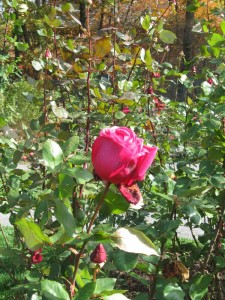
Hybrid Tea Roses
3. Remove all deadwood by cutting out all unhealthy canes. This means dead, diseased or damaged growth. Roses are sensitive to winter frost and the rest of the year are attacked by dozens of fungi, insects, molds, and bacteria.
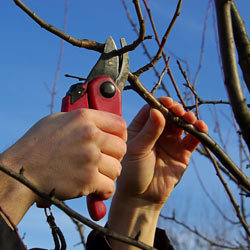
Remove Deadwood
3. Prune to ensure that the center of the bush is open for maximum air circulation. That is, cut out stems that fill up and cross through the center. Remove any branches that are less than the thickness of a pencil, and remove any branches that cross or rub together. Train the rose to grow outwards.
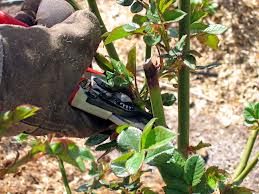
Create Air Space to Prevent Disease
4. Make all cuts above a leaf bud that points towards the outside of the plant. Make all cuts clean – not jagged cuts, as this will allow insects and disease into the plant and open it up to infection. Always prune to a healthy bud. Make sure your cut is at a 45 degree angle going away from the bud.
5. To ensure your plants remain healthy, we recommend painting all cuts with a sealing compound because the plant is not actively growing and can’t defend itself as well against diseases and pests.

Sealing Compound
6. Your Hybrid Tea Roses should look like this after it has been pruned (v shaped).
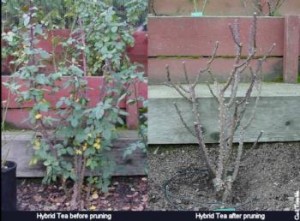
Hybrid Tea Rose Before and After Picture
For the best results, DK Landscaping recommends pruning your roses before Valentine’s Day! So put on a long-sleeved shirt and gloves and grab some sharp pruning shears and make a date with your rose or give DK Landscaping a call at (707) 280-3632 to get your hybrid tea roses bearing the champion flowers that it was meant to be by spring!
Rainscaping Your Landscape
With the rainy season still in store for us in Northern California, it is vital that your landscaping have proper water drainage built in to the design. Without proper drainage, your home and landscape can suffer greatly. Not only can it destroy your plants, yard and your neighbors’ properties, but can lead to serious structural problems for your home and hardscapes, such as cracked housing foundations, water leaks, and flooded sump pumps.
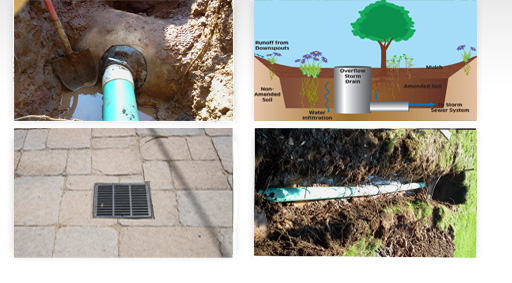
To avoid the nightmare of rather expensive structural problems and flooding, DK Landscaping provides some solutions to poor drainage:
- Proper Grading: Grading (if surface drainage is possible) is often the most inexpensive and most effective solution to correcting an area with poor drainage.
- French Drains: A French drain is basically a ditch lined with rocks or gravel that helps drain water away from an area. French drain works on the principle of gravity, being slightly sloped down from the area to be drained to the area where one wishes to redirect the water. Excess ground and surface water percolates into the French drain and is directed away.
- Catch Basins: Catch basins are simply a reservoir designed to trap debris so that it cannot enter the drainage pipes. Anytime your source of water is above ground, a catch basin can collect the water so that it can be piped away underground. Basins are used primarily when grading is either not possible or when it would create an undesired/unusable space.
- Sump Pumps: Commonly used back East where most homes have basements. Sump pumps are sometimes the only way to remove unwanted water from a location. Many homes have situations where there is no way to drain storm water from their property. If you don’t have a slope away from your property or there is a lower area or sunken area, a sump may be the solution to get the water out.
The primary goal of proper drainage is to remove the water and put it where it belongs: on the street! So whether you are doing it yourself or hiring a professional landscape company, you want to make sure the proper installation methods are being used. If you don’t know what the above bullet points mean, you probably want to hire professionals… this will not only save you a headache, but money in the long run!
For more information and a free consultation on your drainage system, please contact Kathy Lee at DK Landscaping. Kathy is our QWEL (Qualified Water Efficient Landscaper) Certified Irrigation Expert. We are also a certified WaterSense Partner. QWEL and WaterSense are certified by the EPA.
Protecting Your Landscape From Frost Bite
The temperatures in Northern California are beginning to drop which means winter will be before us, before we know it. Night time temperatures that get down to freezing and below will damage some trees and plants if you don’t take precautions against frost. These low temperatures can begin late November and continue through February and beyond.
DK Landscaping helps you prepare your landscape and provides tips to protect your delicate plants from frost bite.
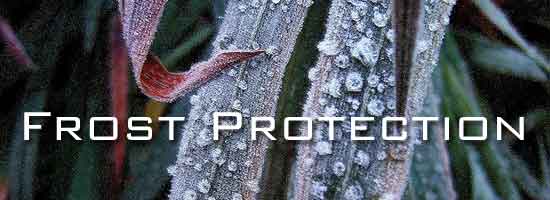
WINTERIZE
Fall is prime time to clean up your landscaping and remove the dead landscaping before it gets too cold. Removing dead plants can also stop the growth and spread of fungi that could infect your plants’ new growth in the spring.
PLANT
Planting trees and shrubs in the fall is a an optimal time before the first frost arrives and best time to take advantage on some great end of the season deals. Planting in the fall gives roots plenty of time to become established before the next growing season begins. Not only will you get to enjoy the changing leaves for a brief time, you will also put less stress on your young trees because of the cooler weather and rain conditions fall offers.
MULCH
Mulching can be a great first step in preparing for winter’s frost. If you are unfamiliar with mulching, check out our previous blog post called Mulch About Fall. There are many benefits to mulching your lawn and plants, especially before winter. Mulching in the fall can help protect your plant’s roots as well as help them retain moisture during the cold, dry winter.
Just a few preparations for winter can guarantee that your landscaping will come back fresher than ever in the spring.
For more information on the care of your landscape, please contact David or Kathy Lee from DK Landscaping (707) 280-3632.
Mulch About Fall

Did you know that mulching in the fall is just as important as it is in the spring and summer months? We mulch in the spring and summer months to suppress weeds, retain moisture and feed and warm the soil. However, when the temperatures begin to drop and the ground freezes, root systems can be exposed. The primary reason for winter mulching is to protect our plants from the harsh conditions of winter freezes, thaws and winds. Mulch acts as an insulator to balance the temperature creating a warm, heavy blanket of protection.
Neglecting to mulch in the fall can be damaging to your plants in the spring season. And the cost of mulching is nothing compared to the cost of replacing some of your favorite trees and shrubs. It also adds a beautiful aesthetic to your landscape in the winter months.
Using fall leaves as organic mulch is a great benefit to your landscape. They will break down over the course of the wintertime and create a layer of nutrients for your plants to draw from. Adding a layer of leaves over your perennials will help regulate soil temperature of the wintertime, as well as give new shoots a protective blanket as they enter the world in the spring.
DK Landscaping offers mulching installation in Sonoma County. Contact us for more information on the benefits of fall mulching (707) 280-3632.
Boys and Girls Club
DK Landscaping received a call from the Rotary Club called asking if we were interested in assisting them with selecting the proper mulch for the Boys and Girls Club of Rohnert Park’s vegetable garden. Kathy Lee then met with the club’s director, Micki Jones.
While meeting with Micki Jones, Kathy looked around noticed everything was overgrown and looked like a jungle. Upon learning that no one was caring for their landscape due the City of Rohnert Park’s budget cuts, Kathy asked if DK Landscaping can be a corporate sponsor and donate our services.
DK Landscaping is now a proud corporate sponsor and official landscaper of the Boys and Girls Club of Rohnert Park. We donated 20 man hours and cleaned up their jungle. We also spread a bunch of mulch on their flower beds. We are performing maintenance on a weekly basis– 100% donated.
We are also donating an additional $25 to the club with each new maintenance account that we sign up. The minimum we will donate for 2012 is $500 regardless of how many new maintenance accounts we get. If the amount is more than $500 they will get the larger amount.
Cotati Police K-9 Dog Fundraiser
The Cotati Police department’s newest police K-9 is Koda, a 2 ½ year old German Shepherd from the Czech Republic. Koda was acquired by the police department in October 2008 after the unexpected death of police K-9, “D’JANGO” who died on July 22, 2008 from an allergic reaction to a bee sting. In an outpouring of generous support, individuals and businesses throughout Sonoma and Marin Counties donated the funding necessary to purchase Koda and sent him to 10 weeks of training with his handler, Officer Christopher Kaupe.
DK Landscaping contributed the following:Corporate sponsor
- Corporate Sponsor
- Printed, mailed and emailed out hundreds of letters and flyers to neighborhoods and sphere of influence.
- Team of four volunteered for the day of the event.

To read more on this story, go to: http://www.ci.cotati.ca.us/sections/police/k9.cfm
Battle of the Brews
For 16 years, the Active 20-30 Club of Santa Rosa has held the Battle of the Brews fundraiser. This annual event draws an estimated 1,800 attendees each year, and represents a unique opportunity to enjoy one of the largest beer tastings in Northern California while at the same time helping to change the lives of needy children in Sonoma County. All proceeds of this event are placed into Active 20-30’s Youth Benevolent Fund.
The Active 20-30 called upon DK Landscaping for plants to soften up the venue located at the Sonoma County Fairgrounds. DK Landscaping teamed up with The Urban Tree Farm and donated plants for this annual event.







